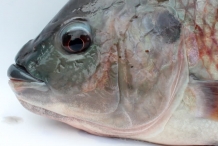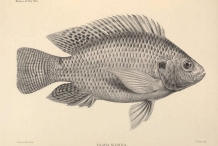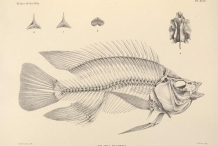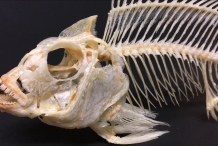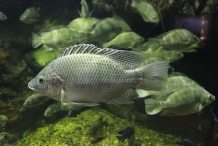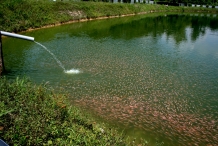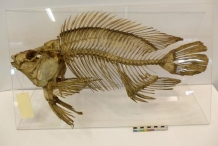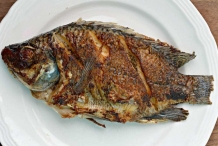Due to its ability to tolerate various environmental conditions, successful reproductive strategies, fast growth and ability to feed various trophic levels, this species is favored among aquaculturists. Some traits allow it to be successful invasive species in temperate and subtropical environments. Being a freshwater fish, it mainly inhabits ponds, shallow streams, lakes and rivers and is commonly found in brackish water. It is the major importance in Africa in artisanal fishing and has increasing importance in aquaponics and aquaculture. It could be a problematic invasive species in warm water habitats such as Australia. It is the fourth mostly consumed fish in United States dating back to 2002.
Description
Nile tilapia possess regular, distinctive and vertical stripes extend as far down the body as bottom edge of caudal fin with various coloration. Adults measures 60 cm long weighing 4.3 kg (9.5 lb). It has the lifespan upto 9 years. It is tolerable to 4.3 kg (9.5 lb). It has the lifespan of 9 years. Being an omnivore, it feeds on plankton and higher plants. This species have high economic value which is introduced widely in its natural range next to Mozambique tilapia (O. mossambicus). This fish feeds on mosquito larvae. The shape of tilapia resembles crappie or sunfish and identified by interrupted lateral one characteristic of Cichlid family of fishes. The body is deep bodied and compressed with long dorsal fins. The dorsal fins forward portion is heavily spined. They are found in anal fins and pelvis. Usually they are wide vertical bars down sides of fry, adults and fingerlings.
Feeding behavior
It is an omnivore feeding on aquatic plants and plankton. Generally, it feeds in shallow water. The temperature fluctuations found in deep waters and harmful gases poses problem for physiology of fish. It prefers warmer temperatures found commonly in shallow waters in comparison to colder environment of deep lake. Generally, tilapias are macrophyte feeders feeding on various filamentous algae and plankton. They feed during daytime hours. Studies show size dimorphism between sexes results from differential food conversion efficiency than various amounts of food consumed. Though females and males consume equal amount of food, male grow larger due to high efficiency of converting food to energy.
Reproduction
Nile tilapia reproduces through mass spawning of brood within nest made by female. In territoriality, arrangement and sexual competition among males lead to large variations in reproductive success for individuals among group. Genetic effect of such behavior is lowered genetic variability in long run as inbreeding occurs among various generations due to various male reproductive success. Nile tilapia when reached young age of sexual maturation results in high birth or turnover rates. Actually, rapid reproductive rate of individuals have negative impact on growth rate resulting in appearance of stunted tilapia leading in somatic growth in favor of sexual maturation. In the presence of other females, female Nile tilapia either visually or chemically exhibit shortened interspawning intervals. The parental investment by female extending interspawning period. The purpose behind mechanism to promote reproductive advantage of females which do not have to care for young that allows more opportunities to spawn. The reproductive advantage for males goes to more dominant males. Study shows that male has various level of gonadotropic hormones which are responsible for spermatogenesis having dominant males with high level of hormone.
Parental care
The species of genus Oreochromis care for their young through oral incubation of eggs and larvae and mouthbrooding. They are maternal mouthbrooders and extensive care is provided by female. They spawn in the nest made by male and eggs or young fry are carried by mother in a mouth for 12 days. When the mother believes that it is not ready for outside, it pushes the young back into her mouth. They provide parental care in troublesome situation. Young swim back for the protection into mother’s mouth. Mouthbrooding results to vital metabolic modification for mother as emulated by fluctuations in low fitness and body weight. The protection of young assures passage of individual’s genes into future generations and caring for young lowers individual’s own reproductive fitness. Spawned eggs size directly correlates with benefits concerning hatching time, survival, growth and onset of feeding since increase in egg size refers increase nutrients for developing young.
Life Cycle
It reaches sexual maturity in 3 to 6 months that depends on temperature in reaching about 30 g. The reproduction occurs when temperature are above 20°C. Spawning occurs several yearly every 30 days.
Health Benefits of Tilapia
Tilapia helps to strengthen bones, maintain psychological health, maintain cardiovascular health, fight cancerous cells, help heal wound, promote weight loss, prevent premature aging, treats thyroid problems, maintain skin health, improve immune system and support hair health. Food rich in omega-3 fatty acids or protein are recommended to consume regularly.
- Psychological health
Tilapia is rich in omega-3 fatty acids which help to nourish brain as it promotes neurological functions. Tilapia consumption helps to promote concentration and provides clarity to mind. Tilapia provides adequate amounts of selenium.
- Strengthening bones
It is recommended to consume foods enriched with phosphorus and calcium for enhancing bone density. Tilapia is helpful for bones. It has collagen type-one which is used in regenerative medicine. Minerals available in fish prevent the chances of fractures and other bone problems. It promotes brain health and also strengthens cells to counteract off factors leading to various diseases such as Alzheimer’s, epilepsy and Parkinson’s. Add single serving of Tilapia fish to increase flow of oxygen to brain and effectively balance fluids. It contains minimum calories and no fat and cholesterol. It is helpful for people with chronic problems.
- Combat cancer cells
Selenium helps to counteract free radical activity which is harmful for overall health. It encounters the demerits of oxidative stress in the body. Similar to antioxidants, selenium helps to eradicate cancerous cell. The consumption of effective nutrient from natural sources such as tilapia fish helps to gain benefits. Studies are being carried out for identifying how selenium helps to inhibit cancerous cells mutation.
- Cardiac health
Omega-3s helps to maintain cardiac health. It does not contain omega 6 and omega 3 fatty acids that helps to lower calories. It is an excellent source of food which deals with various cardiac problems. It has no fat and cholesterol. It lowers high blood pressure that causes heart attack and stroke.
- Assist to lose weight
Individuals who are overweight can add tilapia to diet because it contains zero fats and 36% calories. It is a great source to reap proteins that helps to strengthen muscles. Besides this, other nutrients makes the body energized.
- Healing of wounds
Tilapia assists in production of collagen and heals scratch wounds faster. The consumption of this fish helps to speed up recovery process of wounds. Moreover, nutrients assist in regaining stamina or strength which is lost after an injury.
- Thyroid health
Hormonal imbalance or thyroid problems are caused due to various reasons. It could be treated by natural sources and prevent body from falling prey to other health problems. Tilapia has selenium that promotes regular functioning of thyroid gland. Metabolism combat factors which contributes to weight fluctuation with health problems related with thyroid malfunction.
- Prevention of early aging
Tilapia contains various vitamins such as Vitamin Bs and Vitamin E which eliminates damaging factors contributing early aging. Vitamins help to eliminate health damaging factors resulting early aging. Various internal and external elements are responsible for the condition and daily intake of minerals, vitamins, antioxidants and proteins could treat it effectively. It is required to add foods rich in nutrients. It helps to combat factors such as free radicals that cause oxidative stress to organs. Oxidative stress is responsible for damaging cells those results in saggy skin, gray hair and various degenerative diseases.
- Strengthen immunity
The immune system helps to prevent body from various diseases. Strong immunity is essential for treating flu to destroy cancerous cells. For this, one requires adequate nutrients for enhancing function of immune system. Tilapia is a great food source being loaded with essential nutrients. It strengthens immune system with the consumption of fish on daily basis.
- Healthy skin
Many dream of having clear skin with natural glow. The skin condition is based on the diet being consumed. Tilapia comprises of Vitamin B and E which is well known for treating skin problems such as eczema.
- Strengthen hair
Tilapia is loaded with omega-3 fatty acids that improve scalps and strengthen hair strands. Hair requires nourishment and wild tilapia fish contains essential nutrients.
- Source of protein
Today we could find various protein supplements in the market. It is shown that nutrients are required for treating various health problems. Consume these nutrients by natural sources such as tilapia fish to avoid its adverse effects.
How to Eat
- It is deep fried, grilled, salted and also steamed with lime.
- Tilapia fish is battered and panfried whole.
Precautions
- The consumption of Tilapia if one is trying to reduce inflammatory diseases such as heart disease.
- Farmed ones contain arsenic that leads to arsenic poisioning.
- Farmed tilapia results to increase in inflammation leading weight gain, arthritis and heart diseases.
- Imbalance ratio of Omega-6 and Omega-3 causes heart disease and hypertension.
- Tilapia in farms have polychlorinated biphenyls (PCBs), organophosphorus (OPs), organochlorine (OC), trifluralin pesticides and hexachlorobenzene (HCB) causing diseases or even death.
References:
https://www.itis.gov/servlet/SingleRpt/SingleRpt?search_topic=TSN&search_value=553310#null
https://www.cabi.org/isc/datasheet/72086
https://en.wikipedia.org/wiki/Tilapia
https://www2.ca.uky.edu/wkrec/tilapiabiologyhistory.pdf
https://thehealthyfish.com/the-3-different-types-of-tilapia/
http://www.tradexfoods.com/fish-species-encyclopedia/tilapia
https://www.stylecraze.com/articles/benefits-of-tilapia-fish/#gref
http://www.chefs-resources.com/seafood/finfish/tilapia-fish/
Comments
| Tilapia fish Quick Facts | |
|---|---|
| Name: | Tilapia fish |
| Scientific Name: | Oreochromis niloticus |
| Origin | Native to North, East and Central Africa, and Israel |
| Colors | Blue-gray |
| Shapes | Laterally compressed, deep bodies |
| Flesh colors | Raw: White or pinkish-white; Cooked: White |
| Calories | 111 Kcal./cup |
| Major nutrients | Selenium (86.00%) Vitamin B-12 (67.50%) Isoleucine (63.46%) Lysine (60.23%) Threonine (57.16%) |
| Health benefits | Psychological health, Strengthening bones, Combat cancer cells, Cardiac health, Assist to lose weight |
| Name | Tilapia fish |
|---|---|
| Scientific Name | Oreochromis niloticus |
| Native | Native to North, East and Central Africa, and Israel |
| Common/English Name | Baringo tilapia, Cichlid, Edward tilapia, Mango fish, Mozambique tilapia, Nile mouthbreeder, Nile mouthbrooder, Nile tilapia, Nilotica, Suguta tilapia, Tilapia, Turkana tilapia |
| Name in Other Languages | Amharic: Koroso; Arabic: Bulti; Czech: Tlamoun nilský; Danish: Nil-mundruger, Nilcichlide; Ewe: Akpafiatsi, Gbolonu, Logokpa; Ethiopia: qoroosoo, koroso; Fijian: Maleya; Finnish: Niilintilapia; French: carpe, Tilapia du Nil, Tilapia, Lapia; German: Baringo-Nilbuntbarsch, Lake Eduard-Nilbuntbarsch, Nil-Maulbrüter, Nilbuntbarsch, Tilapie; Ghana: didee, akpafiatsi; Hausa: Bugu, Falga, Garagaza, Gargaza, Karfasa; Hebrew: Amnun yeor; Igbo: Ifunu, Mpupa; Irish: Didee; India: tilapia; Israel: amnun yeor; Japanese: Chikadai; Kanuri: Karwa; Kenya: chambo, nyamami, ngege; Laos: nin; Khmer: Trey tilapia chhnoht; Korean: nailtillapia (나일틸라피아); Malay: nila; Mandarin Chinese: Dà lín kǒu fū fēi zéi (大鱗口孵非鯽), Ní luó kǒu fū fēi jì (yǐn (尼罗口孵非鲫(引), Ní luó kǒu fū yú (尼罗口孵鱼), Ní luó fēi jì (尼罗非鲫), Ní luó kǒu fū yú (尼羅口孵魚), Ní luó fēi zéi(尼羅非鯽), Bālín kǒu fū fēi zéi (巴林口孵非鯽), Bālín kǒu fū fēi jì (巴林口孵非鲫), Gé wén kǒu fū fēi zéi (格紋口孵非鯽), Wò shì kǒu fū fēi zéi (沃氏口孵非鯽), Fēi luò kǒu fū fēi zéi (菲洛口孵非鯽), Sà gé kǒu fū fēi jì (萨格口孵非鲫); Nigeria: bugu, falga, epia, garagaza, ifunu, gargaza, karfasa, karwa, mpupa, tsokungi, tome, ukuobu; Oromo: Qoroosoo; Philippines: pla pla, tilapiya, tilapia; Polish: Tilapia nilowa; Portuguese: Tilápia, Tilápia-do-Nilo; Russian: Tilapiya nil’skaya (Тилапия нильская), Tilapiya n (Тилапия н); Spanish: Mojarra, Tilapia, Tilapia del Nilo, Tilapia nilótica; Senegal: was; Swahili: Ngege, Perege, Sato, Uganda; Swedish: Munruvare, Niltilapia; Tagalog: Pla pla, Tilapia; Tamil: Tilēppi (திலேப்பி),Tilapia; Thai: Plā nil (ปลานิล), Pla nil; Tanzania: chambo, perege, ngege, sato; Thailand: pla nil; Uganda: ngege; Vietnamese: Cá Rô phi vằn, Rô phi; Wolof: Wass; Yoruba: Epia |
| Body shape & size | Laterally compressed, deep bodies |
| Flesh | Raw: White or pinkish-white Cooked: White |
| Color | Blue-gray |
| Flavor | Mild |
| Taste | Light, flaky |
| Texture | Firm |
| Major Nutritions | Selenium, Se 47.3 µg (86.00%) Vitamin B-12 (Cobalamine) 1.62 µg (67.50%) Isoleucine 1.061 g (63.46%) Lysine 2.014 g (60.23%) Threonine 1.006 g (57.16%) Valine 1.114 g (52.75%) Tryptophan 0.231 g (52.50%) Leucine 1.775 g (48.02%) Protein 22.75 g (45.50%) Histidine 0.509 g (41.31%) |
| Health Benefits |
|
| Calories in 1 fillet (87 g) | 111 Kcal. |



